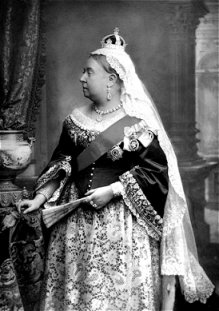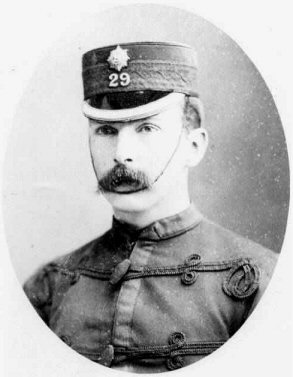HISTORY OF THE 29TH (WORCESTERSHIRE) REGIMENT
by H. Everard
The history of the 29th Foot (Worcestershire) Regiment was written by the then Lieutenant H. Everard and covered the period from 1693 to 1891. The original book was dedicated to Queen Victoria The chapters of this book will be available here online and will provide a detailed insight into the Regiment from its formation in 1694 to 1891. The spelling and abbreviations are printed here as they appear in the original book. Click on the Chapter below to view that section of the book
Note: Chapters will be added over time. Keep checking. |
Queen Victoria
|
PREFACE
The Records in possession of the Regiment appear to have been originally collected and brought down to November, by Col. Enys, who joined the 29th in 1775. In this Officer’s MS. Records, which a few years ago were kindly placed at my service by Mr. F. Enys, is the following paragraph :— "The Records were completed at the desire of the 29th, in consequence of an order, dated..........., desiring a Book to be kept, in which all the principal events of the Corps were to be kept in future, with as much of its former history as they could collect. Among others, I was applied to, and took great pains to ascertain the true from the false part of the Reports we had heard from various persons at various times; but when it was completed, Lieut.-Col. (now Sir Gregory) Way, who then commanded the Regiment, thought they were too full and particular, in consequence of which, the copy sent to the Regiment was curtailed very much, and I have no doubt but that they made them still shorter before they put them into the Orderly Book."
When Col. Enys joined the 29th, Captain Roberts (who we can trace as being in the regiment in 1742) had been its adjutant thirteen years, and it is most probable that the previous history was in a great measure obtained from this officer, who, in turn, had received it from his predecessors; for although somewhat meagre, still it is substantially correct, and, with one exception, I have been able to prove all the traditions and statements. The tradition in question is -- that the Regiment was either raised from the City Trained Bands, or by the Merchants of the City of London, and that such being the case, it, conjointly with the Buffs, enjoys the privilege (I am told on good authority that no regiment has a "right" for so doing, although from time to time this privilege has been granted) of marching through the City with drums beating, colours flying, and bayonets fixed.
With regard to the Trained Band theory, Sir J. B. Monckton, F.S. A., the Town Clerk, writes, that, after a careful search through the documents kept at the Guildhall, he has not been able to trace the raising of, or order to raise, any regiment in the City between 1693 and 1702.
Having carefully looked through the names of officers belonging to the Trained Bands between 1682 and 1694, I have discovered but one (Thomas Farrington to be Lieutenant in the White Regiment, 16th April, 1690) whose name corresponds in any way with those appointed to Colonel Thos. Farrington’s regiment previous to 1703. At this remote period no trace exists as to whence the non-commissioned officers or the rank and file were obtained, but "The Declaration for the More Speedy Raising and Compleating the Fool Regiments," shows that the regiment was raised by order of the Government, and the following is a List of Officers (Commission Books, War Office) appointed to it on the 16th February, 1694: —
Captains |
Lieutenants |
Ensigns |
| Col. Thos. Farrington | Capt.-Lieut. James Howard Barlow Wickham | |
| Lieut.-Col. William Froude was appointed Lieut.-Col. 1st April, 1694 |
Richard Hargrave | Stanley Russell |
| Major Christopher Wray | John Danvers | John Brooks |
| Robert Minzeis | William Carr | |
| John Daily (Grenadiers) | John Greenwood | |
| Francis Lewis | ||
| Anthony Hammond | John Wright | Charles Sweeting |
| Richard Nanfan | Robert Carr | |
| Charles Cracherode | Rowland St. John | James Dennis |
| Peter Minshull | Vere Harcourt | William Franks |
| John Bickley | Charles Middleton | Anthony Gawdy |
| Robert Thorold | William Baker | Robert Utworth |
| Samuel Pitman | Robert Ficke | Thomas Ashmold |
| Robert Cheney | David Chastelain | Peter Bonafous |
| Chaplain — | Hancock | Qr.-Master — | James Howard | |
| Adjutant — | John Wright | Surgeon — | Abraham Silk was appointed on 28th February, 1694 |
There were City Merchants at this time of the names of Lewis, Wright, St. John, Middleton, Baker, and Sweeting, and the father of Col. Farrington was also one. In the Roll of Members of the H.A.C., (The Ancient Vellum Book of the Honourable Artillery Company, being the Roll of Members between 1611 and 1682, by Lieut.-Col. G. A. Raikes) the surnames of over twenty of the officers of Farrington’s regiment occur, and under that of Farrington we find a Daniel, also a Thomas, who was appointed lieutenant on July 29th, 1681.
It should here be mentioned that the photograph of our first colonel, for which I am indebted to Miss S. M. ffarington, of Worden, is taken from an oil painting by the Dutch artist, Willem Wissing, who died at Burleigh on September moth, 1687. The fact of being painted in armour more than a year prior to being appointed to the 2nd Foot Guards (For many years after this, officers were gazetted to the "2nd Regiment of Foot Guards," but occasionally, in parenthesis, is inserted "called the Coldstream Regiment" at other times "2nd Foot Guards called the Coldstreamers." —Military Entry Books, Commission Books, and Harleian MS.) , leads one to think that Thos. Farrington had some previous connection with the profession of arms.
H. Everard |
Although, on returning from Holland in 1799, the privilege of marching through the City with drums beating, etc., was denied the 29th, still it appears from General Walter’s letter that through the interest of Col. Hon. C. A. Wrottesley, it was in 1839 granted and exercised. In publishing the History of the 29th Foot, which in 1797, Lord Cathcart relates, was the Boast of the British Infantry;” and Sir A. Wellesley, writing from Badajos in 1809 to Lord Castlereagh, was pleased to mention as “the best Regiment in this Army,” I feel many apologies are due to all its ranks for the scant justice done the regiment in the following pages, and regret that the information and help which has so kindly been proffered me on all sides, should not have fallen into more able hands than mine, for I am sure the Records could by others be made much more readable. I wish to acknowledge the great assistance received from the Earls of Cathcart and of Strafford; from Col. R. J. Watson, Major F. Kneebone, and Captain H. Colvill, late of the Regiment; from Mr. Chas. Dalton, F.R.S., Mr. F. Enys, and Mr. S. Milne, the latter having given me much interesting information anent the Uniform, Badges, Buttons, etc., originally worn by the 29th; from the Officials of the British Museum, and Public Record Office, especially Mr. H. Hall, of the latter Institution, who has on several occasions put me in the way of discovering most important information. I beg here to tender my sincere thanks for their kind help. I am also greatly indebted to Major W. M. Prendergast, late 29th Regiment, for his kind assistance in illustrating these Records. H. EVERARD, Late LIEUT. 29TH. REGT.
|



